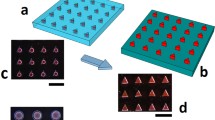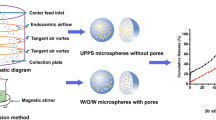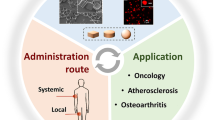Abstract
Purpose
Pulsatile delivery of proteins, in which release occurs over a short time after a period of little or no release, is desirable for many applications. This paper investigates the effect of biodegradable polymer shell thickness on pulsatile protein release from biodegradable polymer microcapsules.
Methods
Using precision particle fabrication (PPF) technology, monodisperse microcapsules were fabricated encapsulating bovine serum albumin (BSA) in a liquid core surrounded by a drug-free poly(lactide-co-glycolide) (PLG) shell of uniform, controlled thickness from 14 to 19 μm.
Results
When using high molecular weight PLG (Mw 88 kDa), microparticles exhibited the desired core-shell structure with high BSA loading and encapsulation efficiency (55–65%). These particles exhibited very slow release of BSA for several weeks followed by rapid release of 80–90% of the encapsulated BSA within 7 days. Importantly, with increasing shell thickness the starting time of the pulsatile release could be controlled from 25 to 35 days.
Conclusions
Biodegradable polymer microcapsules with precisely controlled shell thickness provide pulsatile release with enhanced control of release profiles.







Similar content being viewed by others
References
Leader B, Baca QJ, Golan DE. Protein therapeutics: a summary and pharmacological classification. Nat Rev Drug Discov. 2008;7:21–39.
Aggarwal S. What’s fueling the biotech engine-2009-2010. Nat Biotechnol. 2010;28:1165–71.
Ye M, Kim S, Park K. Issues in long-term protein delivery using biodegradable microparticles. J Control Release. 2010;146:241–60.
Varde NK, Pack DW. Microspheres for controlled release drug delivery. Expert Opin Biol Ther. 2004;4:35–51.
Berkland C, Pollauf E, Raman C, Silverman R, Kim K, Pack DW. Macromolecule release from monodisperse plg microspheres: control of release rates and investigation of release mechanism. J Pharm Sci. 2007;96:1176–91.
Xia Y, Xu Q, Wang C-H, Pack DW. Protein encapsulation in and release from monodisperse double-wall polymer microspheres. J Pharm Sci. 2013;102:1601–9.
Sato K, Takahashi S, Anzai J-I. Layer-by-layer thin films and microcapsules for biosensors and controlled release. Anal Sci. 2012;28:929–38.
Bysell H, Månsson R, Hansson P, Malmsten M. Microgels and microcapsules in peptide and protein drug delivery. Adv Drug Deliv Rev. 2011;63:1172–85.
Sawalha H, Schroën K, Boom R. Biodegradable polymeric microcapsules: preparation and properties. Chem Eng J. 2011;169:1–10.
Rahman NA, Mathiowitz E. Localization of bovine serum albumin in double-walled microspheres. J Control Release. 2004;94:163–75.
Berkland C, Cox A, Kim KK, Pack DW. Three-month, zero-order piroxicam release from monodispersed double-walled microspheres of controlled shell thickness. J Biomed Mater Res. 2004;70A:576–84.
Berkland C, Pollauf E, Pack DW, Kim K. Uniform double-walled polymer microspheres of controllable shell thickness. J Control Release. 2004;96:101–11.
Berkland C, Pollauf EJ, Varde NK, Pack DW, Kim KK. Monodisperse liquid-filled biodegradable microcapsules. Pharm Res. 2007;24:1007–13.
Xia Y, Ribeiro PF, Pack DW. Controlled protein release from monodisperse biodegradable double-wall microspheres of controllable shell thickness. J Control Release. 2013;172:707–14.
Xu Q, Xia Y, Wang C-H, Pack DW. Monodisperse double-walled microspheres loaded with chitosan-p53 nanoparticles and doxorubicin for combined gene therapy and chemotherapy. J Control Release. 2012;163:130–5.
Xu Q, Leong J, Chua QY, Chi YT, Chow PK-H, Pack DW, et al. Combined modality doxorubicin-based chemotherapy and chitosan-mediated p53 gene therapy using double-walled microspheres for treatment of human hepatocellular carcinoma. Biomaterials. 2013;34:5149–62.
Roy P, Shahiwala A. Multiparticulate formulation approach to pulsatile drug delivery: current perspectives. J Control Release. 2009;134:74–80.
Kikuchi A, Okano T. Pulsatile drug release control using hydrogels. Adv Drug Deliv Rev. 2002;54:53–77.
Bussemer T, Otto I, Bodmeier R. Pulsatile drug-delivery systems. Crit Rev Ther Drug Carrier Syst. 2001;18:433–58.
Richards Grayson AC, Choi IS, Tyler BM, Wang PP, Brem H, Cima MJ, et al. Multi-pulse drug delivery from a resorbable polymeric microchip device. Nat Mater. 2003;2:767–72.
Makino K, Mogi T, Ohtake N, Yoshida M, Ando S, Nakajima T, et al. Pulsatile drug release from poly (lactide-co-glycolide) microspheres: how does the composition of the polymer matrices affect the time interval between the initial burst and the pulsatile release of drugs? Colloids Surf B: Biointerfaces. 2000;19:173–9.
Yuk S, Cho S, Lee H. Electric current-sensitive drug delivery systems using sodium alginate/polyacrylic acid composites. Pharm Res. 1992;9:955–7.
Edelman ER, Kost J, Bobeck H, Langer R. Regulation of drug release from polymer matrices by oscillating magnetic fields. J Biomed Mater Res. 1985;19:67–83.
Kost J, Leong K, Langer R. Ultrasound-enhanced polymer degradation and release of incorporated substances. Proc Natl Acad Sci U S A. 1989;86:7663–6.
Siegel RA, Falamarzian M, Firestone BA, Moxley BC. Ph-controlled release from hydrophobic/polyelectrolyte copolymer hydrogels. J Control Release. 1988;8:179–82.
Santini Jr JT, Cima MJ, Langer R. A controlled-release microchip. Nature. 1999;397:335–8.
Bussemer T, Bodmeier R. Formulation parameters affecting the performance of coated gelatin capsules with pulsatile release profiles. Int J Pharm. 2003;267:59–68.
Berkland C, Pollauf E, Varde N, Pack DW, Kim KK. Monodisperse liquid-filled biodegradable microcapsules. Pharm Res. 2007;24:1007–13.
Sanchez A, Gupta RK, Alonso MJ, Siber GR, Langer R. Pulsed controlled-release system for potential use in vaccine delivery. J Pharm Sci. 1996;85:547–52.
Youan BBC, Jackson TL, Dickens L, Hernandez C, Owusu-Ababio G. Protein release profiles and morphology of biodegradable microcapsules containing an oily core. J Control Release. 2001;76:313–26.
Berkland C, Kim K, Pack DW. Fabrication of plg microspheres with precisely controlled and monodisperse size distributions. J Control Release. 2001;73:59–74.
Fu K, Pack DW, Klibanov AM, Langer R. Visual evidence of acidic environment within degrading poly(lactic-co-glycolic acid) (plga) microspheres. Pharm Res. 2000;17:100–6.
Harkins WD, editor. The physical chemistry of surface films. New York: Reinhold; 1952.
Torza S, Mason SG. Three-phase interactions in shear and electrical fields. J Colloids Int Sci. 1970;33:67–83.
van Krevelen DW, editor. Properties of polymers: Their estimation and correlation with chemical structure. Amsterdam: Elsevier Scientific Publishing Company; 1976.
Anastasiadis SH, Gancarz I, Koberstein JT. Interfacial tension of immiscible polymer blends: temperature and molecular weight dependence. Macromolecules. 1988;21:2980–7.
Schwendeman SP. Recent advances in the stabilization of proteins encapsulated in injectable plga delivery systems. Crit Rev Ther Drug Carrier Syst. 2002;19:26.
Emami J, Hamishehkar H, Najafabadi AR, Gilani K, Minaiyan M, Mahdavi H, et al. A novel approach to prepare insulin-loaded poly(lactic-co-glycolic acid) microcapsules and the protein stability study. J Pharm Sci. 2009;98:1712–31.
Houchin ML, Topp EM. Chemical degradation of peptides and proteins in plga: a review of reactions and mechanisms. J Pharm Sci. 2008;97:2395–404.
Fredenberg S, Wahlgren M, Reslow M, Axelsson A. The mechanisms of drug release in poly(lactic-co-glycolic acid)-based drug delivery systems—a review. Int J Pharm. 2011;415:34–52.
Acknowledgments
This work was supported by the National Institute of Health Grant EB005181 and GM085222. Scanning Electron Microscopy took place in Material Research Lab at University of Illinois at Urbana-Champaign. Confocal microscopy measurements took place in Beckman Institute, imaging technology group at University of Illinois at Urbana-Champaign. DSC was performed in Microanalysis Laboratory, School of Chemical Sciences, University of Illinois at Urbana-Champaign.
Author information
Authors and Affiliations
Corresponding author
Electronic Supplementary Material
Below is the link to the electronic supplementary material.
ESM 1
(DOCX 1101 kb)
Rights and permissions
About this article
Cite this article
Xia, Y., Pack, D.W. Pulsatile Protein Release from Monodisperse Liquid-Core Microcapsules of Controllable Shell Thickness. Pharm Res 31, 3201–3210 (2014). https://doi.org/10.1007/s11095-014-1412-5
Received:
Accepted:
Published:
Issue Date:
DOI: https://doi.org/10.1007/s11095-014-1412-5




